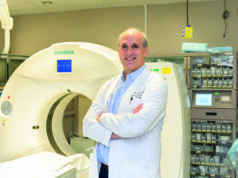
“If interventional radiologists wish to become competitive with surgeons, the availability of software enabling the accurate comparison of pre- and post-interventional CT [computed tomography] or MRI [magnetic resonance imaging] scans must become mandatory and routinely employed,” Luigi Solbiati argues. He discusses the ablation-confirmation software he has developed with his team in Milan, Italy, and enthuses about the potential of artificial intelligence to refine and improve ablative outcomes in interventional radiology.
Many studies in the literature have demonstrated that the outcome of any local tumoural treatments (be it surgery, ablation, or radiotherapy) is largely dependent on the technical success achieved, i.e. if the tumour has been completely or partially treated and, when the treatment is complete, if the peritumoural margins of normal parenchyma are sufficiently and homogeneously thick.
Surgeons have always told interventional radiologists that one of the most significant—if not the most significant—differences between surgical resection and thermal ablation is the modality of assessment of technical success. While surgical specimens are sent to a different department (Pathology) to obtain an accurate assessment, for thermal ablation, technical success is monitored by the same interventional radiologist who performed the treatment (or by other colleagues in the same department). This is done through the comparison of pre- and post-interventional CT or MRI scans in side-by side juxtaposition. This method contains many possible sources of error and can be very challenging, even for experienced radiologists. In a recently published study,1 38 radiologists from many different countries (18 with considerable experience in percutaneous tumour ablation and 20 with limited experience) were asked to assess whether technical success and technical efficacy after thermal ablation of nine hepatocellular carcinomas (HCCs) in nine patients with known outcomes had been achieved using the traditional side-by-side juxtaposition of pre- and post-interventional CT scans. As many as 44.1% of cases per radiologist were misjudged and, more importantly, there was no significant difference between the experienced and unexperienced radiologists.
Consequently, if interventional radiologists wish to become competitive with surgeons, the availability of software enabling the accurate comparison of pre- and post-interventional CT or MRI scans must become mandatory and routinely employed. For this reason, over the last few years I have collaborated with colleagues on the development of a software with these characteristics (Ablation-fit; R.A.W. Srl, Milan, Italy). Our software is based on the automatic segmentation of liver parenchyma and major blood vessels, the semi-automatic segmentation and reconstruction of tumoural targets and post-ablation necrotic areas, and the non-rigid, fully automatic registration of pre- and post-ablation CT scans. This allows for the deformation of liver parenchyma section by section, based on the location of intrahepatic blood vessels, enabling us to achieve an extremely precise image fusion regardless of differences in body position, respiratory motion, or liver deformation. In addition, in very short time (just five to 10 minutes), the software calculates the percentages of residual unablated volumes of both the target tumour and the predetermined 3D safety margin.
In a retrospective study on 90 HCCs that have undergone microwave ablation (MWA) with apparent technical success and followed for at least one year, we demonstrated that, if we could have used this software, we would have discovered incomplete treatments at 24-hour CT scan (enabling immediate re-treatment) in 76.6% of the HCCs that actually had local tumour progression at one year.2
In a recently published clinical study on colorectal liver metastases that had undergone radiofrequency ablation (RFA),3 with volumetric assessment of the periablational safety margin performed with this software, it was proven that the safety margin assessment was the only independent predictor of local tumour progression, and that at least 90% of a 6mm circumscribed 3D safety margin was required to achieve complete ablation.
Ablation-confirmation software like this can be used in different modalities. When ablations are performed in sonographic rooms under the control of contrast-enhanced ultrasound (US), potentially integrated with real-time US-CT/MRI image fusion, ablation-confirmation software like this can be used only after the end of the treatment. In this situation, a level of assessment closer to that achieved by pathologists after surgical resection can be obtained, but if incomplete treatment or insufficient ablative margins are seen, the procedure will have to be repeated, just as in surgery. On the other hand, if ablations are performed under ultrasound or CT guidance in the CT room (as is recommended nowadays),4 the software could be used immediately, intraprocedurally, and the treatment could be adapted in order to complete the intervention without the fear of only obtaining partial or insufficient ablative margins. This intraprocedural use represents an advantage even over surgical resection.
In addition, this kind of software can trace out the ideal path to the portion of tumour to be retreated, thus significantly facilitating the completeness of the procedure.
In the near future, it is hoped that such easily usable and extremely fast software will be increasingly employed in interventional departments. We are currently working to extend their applicability also to extrahepatic organs, such as the kidneys, lungs, lymph nodes, and prostate, as well as to MRI scans.
In the end, it is important to point out that there is a perfect integration between the type of software described above, and one of the most attractive (if not the most attractive) incoming modalities for the guidance of any interventional procedure: augmented reality (AR).5 In addition to the already known and much discussed advantages of AR (its low cost, ergonomic feel, diminishment of the learning curve, particularly in younger users, the opportunities this technology provides for educational purposes), it can be particularly helpful for the guidance of interventional devices into incompletely treated tumoural areas, thanks to its ability to define precise trajectory lines that the operator can simply and automatically follow to reach the targets. The association of increasingly accurate and simple ablation-confirmation software and AR is likely one of the milestones of near future interventional radiology.
Luigi Solbiati is an interventional radiologist at the Humanitas University in Milan, Italy. Disclosure: He is a developer of the Ablation fit software.
References
- Laimer G, Schullian P, Putzer D, et al. Can accurate evaluation of the treatment success after radiofrequency ablation of liver tumors be achieved by visual inspection alone? Results of a blinded assessment with 38 interventional oncologists. Int J Hyperthermia 2020; 37: 1,362–1,367. doi.10.1080/02656736.2020.1857445
- Solbiati M, Muglia R, Goldberg SN, et al. A novel software platform for volumetric assessment of ablation completeness. Int J Hyperthermia 2019; 36: 337–343. doi. 10.1080/02656736.2019.1569267
- Laimer G, Jaschke N, Schullian P, et al. Volumetric assessment of the periablational safety margin after thermal ablation of colorectal liver metastases. Eur Radiol 2021. doi.10.1007/s00330-020-07579-x; Online ahead of print
- Mauri G, Solbiati L, Orsi F, Monfardini L. Thermal ablation of liver tumours: The crucial role of 3D imaging. Cardiovasc Intervent Radiol 2020; 43(9): 1,416–1,417. doi.10.1007/s00270-020-02560-z
- Solbiati LA. Augmented reality: thrilling future for interventional oncology? Cardiovasc Intervent Radiol, 2021. doi.10.1007/s00270-021-02801-9











i agree with the need for such tools. however i
feel that it is inaccurate for prof solbiati to state that he has no relevant disclosures while he involved in a commercial project called “ablation-fit” as founder/shareholder or other roles.